|
There are a number of kinds of mixers, differentiated mainly by capacity and mobility. The whole idea of mixing is to tear the paper apart in water to produce slurry, and then mix in additives like Portland cement and sand. This procedure is followed all the time - when working with small batches in a five-gallon bucket or with 1000 gallon (4500 liter) batches on the back of a 4-wheel drive truck. Get the paper and water mixed first, and then add the other components.
A number of practitioners prefer to purchase paper, which has already been ripped apart by running it through a hammer mill. After milling, it looks like cellulose insulation; the type blown into the roof crawl space of many homes for roof insulation. In fact, it is the same material without moisture resistant and fire retardant chemicals. The advantage of working with hammer milled paper is that most additives can be mixed in using conventional concrete mixers. Other special processes require specialized equipment.
From a size perspective, the smallest practical mixer is a five-gallon (20 liter) bucket and an "X" shaped stucco-mixing blade for a heavy-duty electric drill.
 |
| Heavy duty drill and “X” shaped stucco blade. (See closeup of blade.) |
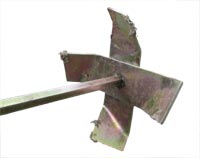 |
| X-shaped stucco mixing blade. |
Using a five-gallon bucket doesn't necessarily mean mixing a full five gallons of slurry. I regularly use it to mix a few coffee cans full of experimental mix. Despite what is written elsewhere, I would advise staying away from the light duty kitchen blender for doing experimentation. First of all, it's hard to get the paper to break up in it and it's unsafe. I found myself wanting to stick things into the blender to help it along as it was running. Not a good idea. Blenders are just not designed for mixing papercrete. They're really not large enough to produce a workable volume of mix, and most of them aren't powerful enough. I burned out a blender and a circular saw (I had adapted it for mixing) before realizing that the motors on those tools produce high speed but relatively low torque. What you need to mix papercrete is power. You need a good deal of force to tear wet paper apart. Since my epiphany, I have been using a Ryobi 3.5 amp double insulated, double isolated hand drill with a top speed of 600 RPM. I can almost twiddle my thumbs faster than this drill spins, but it has great low-end power, and can be used for long periods without overheating. The drill and the "X" shaped stucco-mixing blade, which cost eleven dollars, came from Home Depot.
To make 2.5 gallons of mix in a 5 gallon can, try this:
Water- 2.5 gallons
Paper - 1 lb. 7oz.
Portland
Cement - 1 lb. 17 oz. or (if you have fly ash):
Portland Cement - 1 lb. 9 oz. and fly ash - 8 oz.
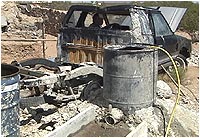 |
| A stationary 50-gallon drum mixer connected to the rear axle of a pickup truck. |
The next larger capacity mixer is the 50-gallon (212 liters) size. These are stationary mixers made from 50-gallon drums. A small 5-10 horse motor is positioned next to and below the drum so that an "L" angle drive shaft can be used to protrude through a hole in the bottom of the drum. A lawn mower blade is attached horizontally on the drive shaft. The blade has to face downward or it will propel the mix out of the drum. A "baffle" (a 2x4 the height of the drum) is bolted vertically at any point on the inside perimeter of the drum to keep the mix from rotating too quickly to tear up the paper and blend well.
50-gallon mixers work well but sometimes need help ripping apart the paper - not enough power. Some people power 50-gallon drum mixers (or much larger mixers made with livestock watering tanks) with old vehicles to provide the power necessary to tear up the paper. For more on 50-gallon drum mixers with electric motors, see the section on Electric Motor Mixers below.
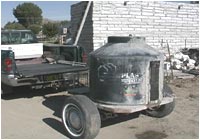 |
| A tow mixer is pulled behind a vehicle to blend the mix. |
The best-known papercrete mixer has to be Mike McCain's tow mixer. Mike came up with the idea of taking the rear axle of a rear-drive car or truck and simply reversing its designed use. In rear-drive vehicles, the engine turns a drive shaft, which is connected to a gearbox called a differential, built into the rear axle of the car. The differential conducts power from the drive shaft to the rear wheels. Mike's vision was this process in reverse.
His design transfers power from the wheels to the drive shaft. He separates the rear axle from the rest of an old rear-drive car or truck. He then mounts a 200-gallon (900 liter) tank over the differential. Turning the differential toward the sky, he pokes a short section of drive shaft from the differential through the bottom of the tank. He then attaches a lawn mower blade to the shortened drive shaft. When the tank is towed behind another vehicle, the wheels on the mixer turn the drive shaft, and the mower blade spins. Since the mower blade is being driven by the power of the vehicle towing the mixer, it turns with relatively low speed, but tremendous force. This force tears apart newspapers and magazines with ease.
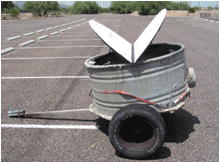 |
We can build a tow mixer for
you. The basic model as shown, but without the cover, costs $2500.00.
Contact us for details and shipping costs. |
|
Tow Mixer & Cover Parts (Approximate Prices) - 2005
Mixer
1 - Used rear axle w/ tires and wheels
1 - Trailer coupler (match ball size)
1 - 20 foot (or 2 - 10 foot lengths) - 2" x 2" steel square tubing
1 - 8-10 foot - 2" x 1/4" metal strapping
1 - Livestock tank (Type A)
1 - Gallon can of Bondo
1 - 6"-8" piece of 10" or 12" diameter PVC
1 - Four foot - 4" x 4"
3 - 3/8 inch diameter x 3" lag screws and washers
3 - 1/2 diameter x 3" long anchor bolts, nuts and washers
1 - Sheet 3/4" exterior plywood
1 - "Handtite" pipe plug - 10" or 12"
1 - Gallon fresh or used heavy motor oil or like amount of grease
1 - Big bottle - Fuller's glue
1 - Riding mower blade or "U" shaped sign post - 27
inches long
Cover
2 - Sheets - 3/4" plywood
1 - 8 foot - 2" x 4"
1 - 5 foot length of safety belt material (fabric store)
1 - 10-12 foot length of 1" wide rubber - for gasket (fabric store)
1 - package - 3/4" staples (for stapling gasket)
1 - package of 5/8" washer screws (for fastening safety belt "hinge")
1 - Package 1 1/2" screws (connecting 2 layers of plywood cover)
1 - Gallon fresh or leftover paint (4 coats) to finish cover
|
$125.00
$ 15.00
$ 30.00
$ 15.00
$200.00
$ 20.00
$ 10.00
$ 6.00
$ 3.00
$ 9.00
$ 30.00
$ 86.00
$ 5.00
$ 7.00
$ 50.00
$ 60.00
$ 4.00
$ 5.00
$ 3.00
$ 3.00
$ 3.00
$ 2.00
$ 20.00
|
I have seen a few tow mixers in action. They work well if they are designed correctly. When they are working well, driving at five miles (8 kilometers) per hour for less than mile (less than 1.5 kilometers), will mix the paper and water or the entire mix if Portland cement and other admixtures have been added. (The water and paper will be pulped alone when making stucco and plaster. Applying stucco and plaster takes time so the pulp is mixed with Portland in smaller batches in a small mortar mixer as needed.)
One of the tow mixers I saw had an unusual custom-made blade, which was incorrectly designed. When this tow mixer was barely moved, it flung mix outward and skyward creating a papercrete mushroom cloud. It also required quite a bit of arm-deep repositioning of the wet paper to get the mix well blended, which took a considerable amount of time.
Ironically, the only complaint I've heard about properly designed tow mixers is that they have to be towed. If building in extremely rough terrain, there might be very little room for towing. That is a valid concern but I have seen one used on a small building site being towed in tight circles right around the home being built. Remember, this mixer is towed at walking speed, so it really doesn't take much room to tow it around.
One valid complaint about
tow mixers (up to now at least) is that they are difficult to seal – especially
before the paper has been broken down somewhat. Some people were using toy
balls to seal short lengths of
PVC pipe installed (with Bondo) in the rear wall of the mixer. The problem with
the ball approach is that it always leaks and when you remove the ball, there is
no way to control how fast the mix comes out. I’ve been using a Hand-Tite Pipe
Plug, which seals very well but doesn't easily control the outflow. The best
approach came from Cris Ackerson, one of my workshop attendees. She came up
with a device called a Slide Ditch Gate used in irrigation systems. It comes in
many sizes, which seal extremely well and fit inside PVC of various diameters or
can be installed without the PVC. It can be easily slid up, down, or closed
completely to control how much mix comes out. The one in the picture was welded
in place to give it additional stability.
|
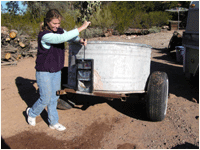 |
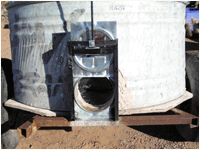 |
|
Cris
Ackerson adjusts the Slide Ditch Gate on her tow mixer. |
The Slide Ditch Gate seals the tow mixer completely
and controls the outflow of the mix extremely well. |
To date, there are two approaches for mixing large batches of papercrete. Mike McCain’s approach is to weld a second gear case over the rear differential on a four-wheel drive vehicle - such as the Ford F-150. This top gear case has a vertical shaft, which protrudes through the truck’s bed and the bottom of a 1000-gallon plastic drum. A large horizontal blade, made of signpost steel, is connected to this shaft inside the drum. The advantage of this setup is that the mixing is done while standing still.
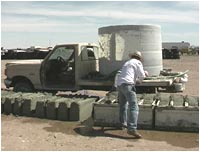 |
| Mike McCain levels fresh mix just poured into his metal forms. Blocks poured about a half-hour earlier are set, and standing on their own to the left. |
To mix papercrete, the rear drive shaft is connected to a
second differential welded on its side above the manufacturer's differential - which normally drives the rear wheels. One of the axles from the top differential is removed so that it can be turned on its side.
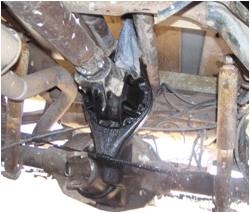 |
| The key to Mike Mccain's big mixer is a second differential welded on its side above the manufacturer's differential. Note that the drive shaft is disconnected from the manufacturer's differential and connected to the one which drives the mixer blade. |
The other axle protrudes through the bottom of the tank and drives the blade inside the tank. By engaging two-wheel drive, the mixer blade is set in motion with the truck standing still. The blade speed is controlled by means of the accelerator pedal. If four-wheel drive is engaged, the front wheels are powered so that the truck can be moved around. That means the 1000 gallons of mix can be moved to where it is needed.
Zach Rabon does his mixing in a conventional cement truck. He uses paper which has already been hammer-milled. It is like cellulose attic insulation without the chemicals to retard fire and moisture. After blending his additives in the rolling cement truck mixer, the mix is sent down the chute into forms.
After abruptly burning out a few small electric motors trying to mix papercrete, I'm not an avid proponent of electric motors. In fairness, I know of a beautiful home built entirely with a large stationary electric mixer, however, he had access to utility power while he built his home. Producing electricity on a remote construction site usually means buying a generator. For papercrete, the mixer will require at least a five horsepower electric motor, and that's underpowered from my point of view. If you install a motor heavier than five horsepower, a larger generator will probably be necessary. In many cases, a generator is going to be needed to run electric tools on the construction site anyway, but maybe not as large a generator as one to run a heavier electric motor. Every time it's turned on, the larger generator is going to consume more fuel than would have been needed for a smaller generator. So the larger electric motor penalty has to be paid whether using the mixer or not. With the tow mixer, you only burn gas when mixing. An electric mixer may be a better idea if you have ready access to utility power, but there are two other interrelated issues with electric motors - convenience and safety.
Electricity doesn't mix well with water. The areas around stationary papercrete mixers get wet and stay wet. A situation like that can lead to equipment damage or bodily injury. The electric mixers I've seen have motors that are mounted above and to the side of the mixing tank. They have to be mounted higher than the surface of the tank to keep them out of the wet area and align them with the blade's drive shaft. The pulley on the motor is connected to a pulley mounted over the center of the tank. This center pulley is connected to a shaft, which holds the blade a few inches above the bottom of the tank to do the mixing. So whenever the motor is turned on, hands are often within a very short distance of a moving belt and a spinning shaft. When something has to be added to the mix, and this is a frequent operation, one has to remember to turn off the motor or risk catching a hand, piece of clothing, a tool or a cement bag in the spinning belt pulley or around the spinning shaft. I am told that the more one works around an electric papercrete mixer, the more tempting it is to leave the mixer on when adjusting the mix. Cautious people install safety cowling over the moving parts to prevent injury, but I have seen several without.
With a tow mixer, one has to stop the vehicle and get out to observe or adjust the mix. When the vehicle is stopped, the blade stops, hence no safety issue.
There are, however, many people who prefer electric motor mixers and have used them successfully.
Kelly Hart has used a 1/2hp electric motor on a 50 gal. drum mixer for seven years with great success. He even ran it on solar energy.
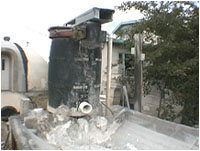 |
Eric Patterson, one of the fathers of papercrete, has a unique 50 gal. drum mixer with an electric motor. He built his mixer on a slightly elevated platform so that the mix can be released onto a screen. Beneath the screen is a curved sheet of corrugated metal mounted on an incline to a small livestock tank. The corrugated metal sheet catches the water draining from the mix and carries it into the tank. The tank has an underwater pump, which propels the water through the PVC pipe (vertical-just to the right of the mixer) from the bottom of the tank back up into the mixer. |
|
Eric Patterson's unique mixer with water capture and reuse feature. |
As papercrete technology evolves, there will undoubtedly be changes in the way it is mixed and used. |
Recently, a different type of electric motor mixer is being developed for an alternative mix of papercrete. It is intended for the small contractor rather than the individual builder. It has extensive safety features such as ground fault interrupters as well as two motors and twin lawn mower blades. Using this mixer, with an additive like ground Styrofoam, reportedly eliminates almost all shrinkage and warping of the papercrete block. Initial tests with this new material and its preparation are promising.
More on this as information becomes available. |